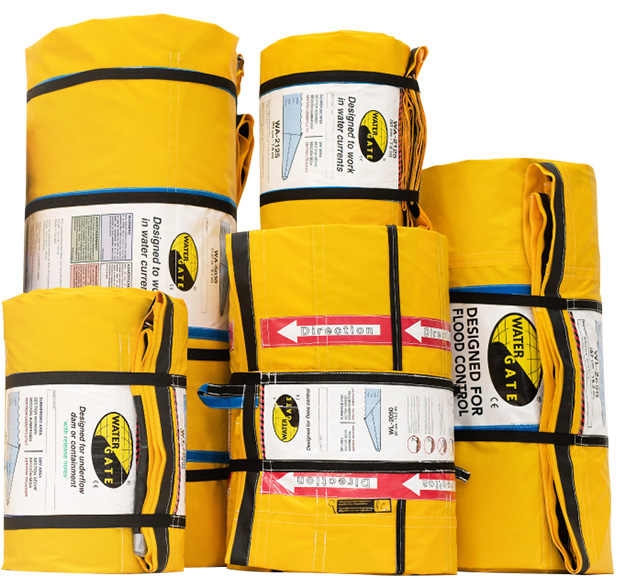As an example, the following image shows a property protected by the Water-Gate Barrier. Follow the eight (8) important steps to determine what you need. Take into consideration any obstructions around the building (pools, trees, sheds, etc.).
- You will need a clear path of at least 2 feet around the perimeter of the structure that is being protected.
- A clear path will be required to place the Water-Gate into proper position
- Multiple pumps are required to pump rain & seepage water away from the back end of the Water-Gate.
- Choose pumps with a capacity of 2 to 14 liters / minute for
- It is possible to create 90-degree corners by folding unit properly.
- It is possible to attach units together thank to our integrated Velcro system.
Take into consideration the direction of water and make sure the barrier is positioned properly.

How to determine the required length?

The calculation of the required length is always made from the red line as shown on the front page.
- Select height of protection needed:
- Height can vary based on historical experiences, slopes and other factors.
- Take into consideration the lowest point of your property to determine the required height.
- Review chart below for distance required for placement of Water-Gate (red line).
- Pay great attention to obstacles:
- Increase length as needed to avoid any obstructions or create corners to circumvent them.
- Connecting edge joints need to be at least 5ft away from corners.
WATER-GATE – TIPS
Make sure to select the right size of barrier and to use sump pumps or other available tools to prevent infiltrations and rainwater. Avoid Velcro joints at corners.6” high Water-Gate unit cannot be joined to any other Water-Gate height, all others are connectable.Review all obstructions when measuring how much room you will need to deploy the Water-Gate properly. Each Water-Gate has a 4 :1 ratio of depth to height for secure stability, which guarantee a long-term stability.
Sandbags are needed on front edges where there are specific creases or folds and throughout unit to prevent seepage. Water-Gate barriers are FM Approved.
THE 4 GOLDEN RULES TO SUCCESSFULLY INSTALL THE BARRIER
1- NEVER TRY TO CONTAIN A LEAK BEHIND THE BARRIER
If there are leaks, prevent water from seeping in front of the barrier. In most cases, this problem is caused by infiltrations upstream. If you try to control a leak behind the barrier, it could create a small pool below it and make it unstable.
2- PUMP THE WATER BEHIND THE BARRIER
It is important to leave enough space between the building and the back of the barrier to install a water pump. Do not allow water seeping under the barrier to accumulate behind it. One of the next chapters discusses the importance of water pumps.
3- PUT A REGULAR WEIGHT ON THE FRONT BIB
Do not attach the barrier to the ground. Water entering the barrier creates a weight that holds back the incoming water. It is important to place weights on the front to reduce infiltration. The WL model, created for flood control, is designed with integrated ballasts for rapid deployment. The weights reduce infiltration under the barrier and allow it to stay securely on the ground.
4- PREVENT WATER FROM ACCUMULATING UNDER THE BARRIER
Remove any objects that may cause infiltration under the front of the barrier. It is designed to stay in place on all surfaces, be it asphalt, gravel, turf or concrete. However, if there is too much water under the front, the barrier will not stick as well and could slip. Therefore, it is important to ensure that the ground is free from all objects that could cause a build-up of water under the barrier.

General FAQ
Q. What is the recommended way to store the barrier?
Ans: We do recommend to store the barrier in its carrying bag or a crate. Always keep the barrier away from UV rays to prevent damages.
Q. What to do in the event of a barrier get tear?
Ans: In the event of a tear, you can easily and quickly repair the barrier, even during use. Feel free to contact us for further information.
Q. Who need water barrier & disaster management product?
Ans: MegaSecur is proud to meet the needs of a vast and diversified Customers.
Our products are dedicated to Public institutions, municipalities, cities, firefighters, emergency responders, civil security, and other first responders, military forces/Army, large companies, SMEs, Very small business. Resident associations, individuals and more.
Q. What is the typical lifetime of a Water Gate dam?
Ans: The average life span of a Watergate flood protection barrier is between 20 and 25 years.
Q. Can water dame retain a mudflow?
Ans: Yes, any flood carries a more or less quantity of sediment. Mud does not modify the dam stability or efficiency, even in large quantities.
Q. Who need water dam ?
Ans: When a flash flood occurs, response time is critical. The Water‑Gate™ flood dam can be quickly and easily deployed in three easy steps. The design uses the weight of the incoming floodwater to deploy and stabilize itself. Water enters and accumulates at the bottom of the barrier as the water level rises, causing the barrier to unfold and swell. The water pressure will open the dam and keep it in place, regardless of the nature of the terrain beneath the dam.
Step 1: Unroll the barrier. Step 2: Unfold the first fold. Step 3: Allow the water to accumulate inside.
It is as simple as that.
Q. Is it possible to join different barrier together?
Ans: Yes, all Water-Gate water barriers can be joined together regardless of the size or the model, with the exception of the WL-0630 which can only be joined to other WL-0630 barriers. It is recommended to join barriers when dry.
Q. How to schedule a demonstration with a Representative?
Ans: Our advisors can move throughout all around the world depending on their projects and availability. Please feel free to contact us for a comprehensive evaluation of your project.

